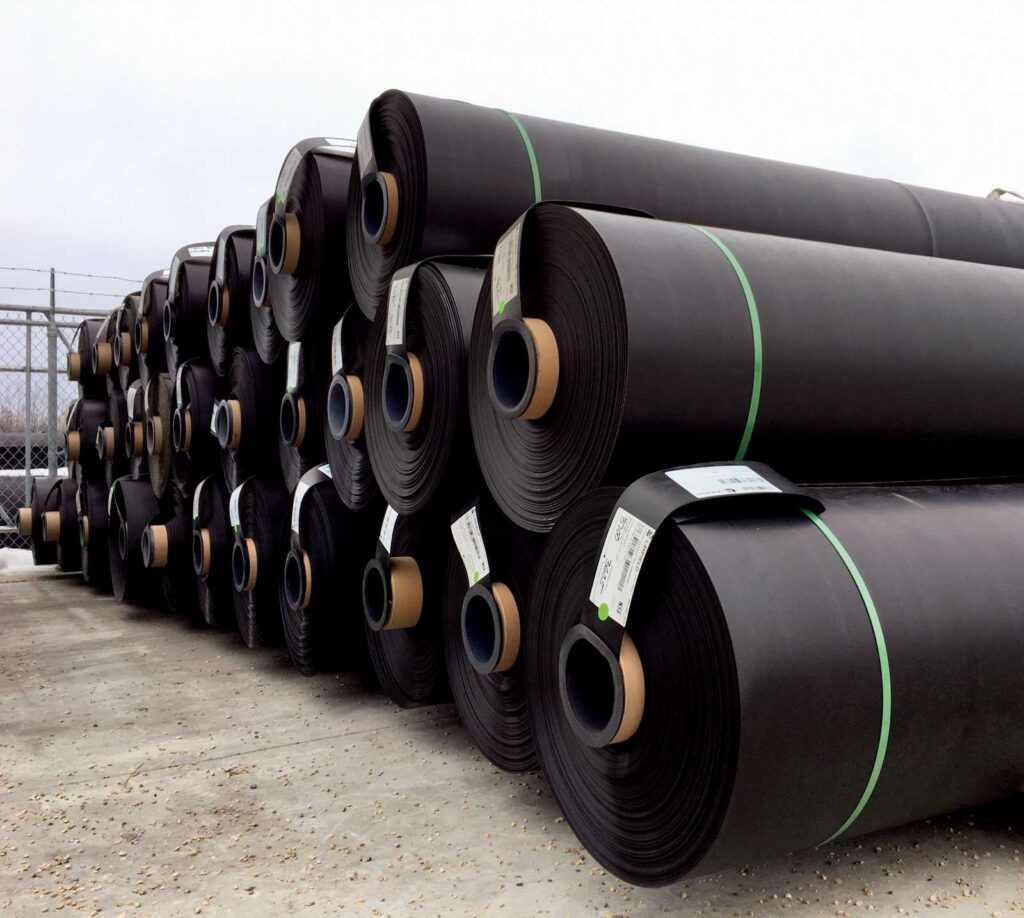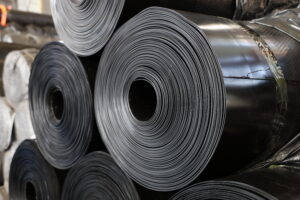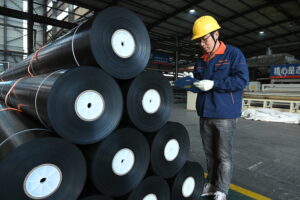Geomembrane stability
The stability of a geomembrane refers to its ability to maintain required performance and durability during use. The following are the main aspects to consider for the stability of geomembranes:
Chemical stability: The geomembrane should have good chemical stability and be able to withstand the effects of soil, water, chemicals, etc. that come into contact with it. It should be able to resist chemical reactions such as corrosion, chemical attack and oxidation to maintain its physical properties and structural integrity.
Ultraviolet stability: When the geomembrane is exposed outdoors, it will be exposed to ultraviolet radiation, so it needs to have good ultraviolet stability. UV stability can be enhanced by adding anti-UV agents or using special materials.
Mechanical stability: The geomembrane should have sufficient mechanical stability to withstand external loads and stresses, such as stretching, tearing, puncture, etc. This helps maintain the integrity and functionality of the geomembrane.
Temperature stability: The geomembrane should have good stability under different temperature conditions and be able to maintain its performance and physical characteristics. It should be able to resist shrinkage, creep or thermal deformation caused by cold and hot temperature changes.
Humidity stability: The geomembrane should be stable in a humidity environment and be able to resist the impact of humidity changes on its physical and chemical properties to maintain the stability of its application performance and structure.
Biological stability: The geomembrane should have certain biological stability to resist the erosion and adhesion of organisms such as microorganisms, fungi, bacteria and insects, so as to extend the service life of the geomembrane.
These stability factors can be improved by selecting appropriate geomembrane materials, additives and manufacturing processes. When selecting a geomembrane, the stability of the selected geomembrane should be evaluated and confirmed based on specific engineering needs and environmental conditions to ensure its reliability and durability in engineering applications.

Chemical stability of geomembranes
The chemical stability of a geomembrane refers to its ability to maintain its structural integrity and performance when exposed to different chemicals and environmental conditions. Chemical stability is one of the most important performance indicators of geomembrane in various engineering applications. The following are factors to consider regarding the chemical stability of geomembranes:
Corrosion resistance: The geomembrane should be corrosion-resistant and able to resist chemicals that come into contact with it, such as acids, alkalis, solvents, and salts. This is especially important because geomembranes are commonly used in various environments such as wastewater treatment, landfills, and chemical storage tanks where they may be exposed to corrosive substances.
Chemical Compatibility: Geomembranes need to be compatible with the chemical components of the soil and environment and not react adversely or dissolve with them. It should not release harmful substances to protect the environment and water quality.
Oxidation Resistance: The geomembrane should be oxidation resistant and be able to maintain its performance in the presence of oxygen and other oxidizing substances. This helps extend the life of the geomembrane, especially in outdoor environments.
UV stability: Geomembranes need to have a certain degree of UV stability to resist the degradation of their materials by ultraviolet radiation. Typically, geomembranes are added with anti-UV agents to enhance their weather resistance.
Biological stability: The geomembrane should have certain biological stability and be able to resist the attachment and erosion of organisms such as microorganisms, fungi, bacteria and insects. This helps maintain the integrity and performance of the geomembrane.
Temperature stability: The geomembrane should be able to maintain its chemical stability under different temperature conditions and not be affected by high or low temperatures or temperature changes.
Chemical additives: When manufacturing geomembranes, chemical agents can be added to improve its chemical stability, such as antioxidants, ultraviolet absorbers, etc.
Geomembrane-soil interaction: In some applications, the interaction between the geomembrane and the soil also needs to be considered to ensure the stability and compatibility of the geomembrane in the soil.
When selecting a geomembrane, the specific engineering application and environmental conditions need to be considered to ensure that the selected geomembrane has the appropriate chemical stability to meet the project’s requirements and sustainability goals. Typically, manufacturers provide detailed information on the chemical stability performance of geomembranes.

Temperature stability of geomembrane
The temperature stability of a geomembrane refers to its ability to maintain its structural integrity, physical properties and chemical stability under different temperature conditions. Temperature stability is one of the most important performance indicators of geomembrane in various engineering applications. The following are factors to consider regarding the temperature stability of geomembranes:
High temperature stability: The geomembrane should have good high temperature stability and be able to maintain the stability and physical properties of the structure under high temperature conditions. The requirements for high-temperature stability depend on the specific application scenario, such as high-temperature environments such as compost sites and landfills.
Low temperature stability: The geomembrane should have good low temperature stability and be able to maintain the stability and physical properties of the structure under low temperature conditions. The requirements for low temperature stability depend on the specific application scenarios, such as cold ground engineering, ice and snow covered areas, etc.
Temperature change stability: The geomembrane should have good temperature change stability and be able to maintain the stability and performance of its structure during temperature changes. The requirements for temperature change stability depend on the specific application scenario, such as areas with large temperature differences between day and night.
Thermal expansion coefficient: The thermal expansion coefficient of a geomembrane determines the degree of dimensional change when the temperature changes. A smaller thermal expansion coefficient helps reduce the impact of temperature changes on the geomembrane and maintains its structural stability.
Freeze-thaw resistance: For application scenarios that often experience freeze-thaw cycles, such as roads and ground engineering, geomembranes need to have good freeze-thaw resistance and be able to resist structural damage and performance degradation caused by freeze-thaw cycles.
Heat distortion temperature: The heat distortion temperature of geomembrane refers to the temperature at which shape changes and mechanical strength begin to occur under high temperature conditions. A high thermal deformation temperature indicates that the geomembrane has good thermal stability.
When selecting a geomembrane, the temperature stability of the selected geomembrane needs to be evaluated and confirmed based on the specific engineering application and environmental conditions. Manufacturers often provide detailed information on the temperature stability and related properties of geomembranes. Please note that different types of geomembranes may have differences in temperature stability, so when selecting a geomembrane, special attention should be paid to its applicable temperature range and environmental requirements.





